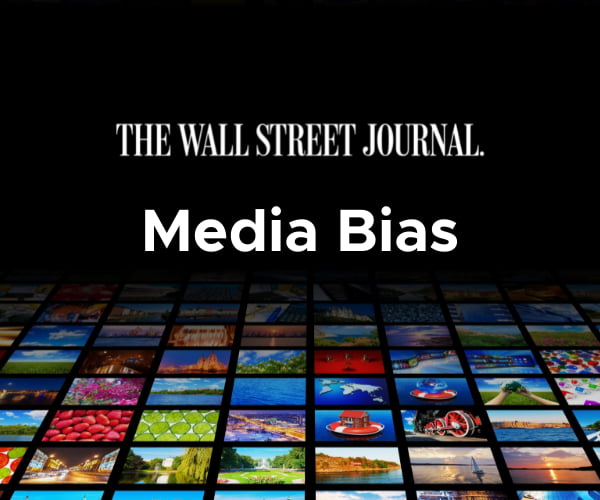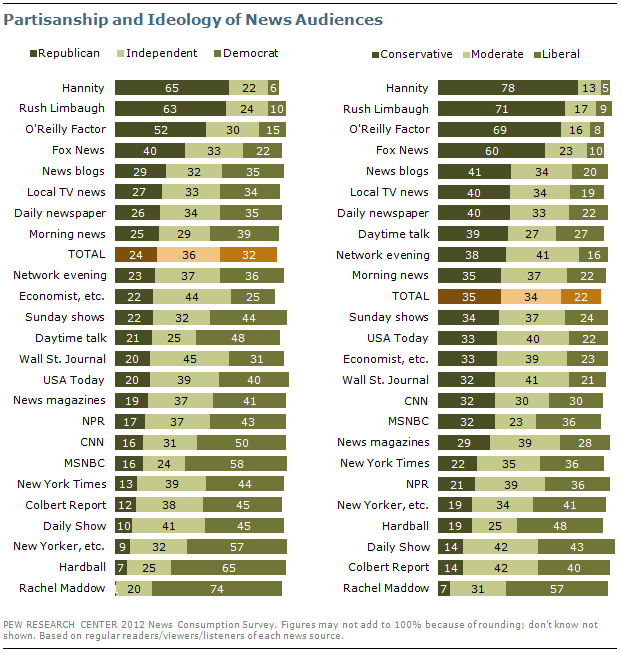
The Wall Street Journal (WSJ) is a business newspaper based in New York City that has been in circulation since 1889 and has won 38 Pulitzer Prizes. Since then, the WSJ has expanded into the online space and built a strong reputation for quality coverage of a broad range of topics, including politics, world news, culture, business, and financial news. Its audiences are predominantly males with college degrees in the 30-49 age range and tend to affiliate mostly as political independents and moderates.

Source: Pew Research
The WSJ is known for its rigorous editorial process that emphasizes insightful analysis and fact-checking claims. In 2018, Gallup and the Knight Foundation conducted a survey that found the WSJ was perceived as the fourth-most unbiased news source available to the public — second among Republicans and tenth among Democrats. However, the paper is not without its critics who cite conservative bias in the WSJ’s articles.
This article will evaluate the WSJ’s coverage to determine the extent of bias in its reporting. Our goal is to give readers an objective assessment so that readers can make more informed decisions about their media consumption.
How Does Biasly Rate News Sources?
Biasly’s algorithms produce bias ratings to help provide multiple perspectives on given articles. Biasly has analyzed 200,000+ news articles from more than 3,200 news sources through our A.I. technology and team of political analysts to find the most factual, unbiased news stories.
Biasly determines the degree of political bias in news sources by using Biasly’s Bias Meter Rating, in which Biasly’s team analyzes media sources’ reliability and bias and produces three scores, a Reliability Score that measures the accuracy of media sources; an A.I. Bias Score, evaluated by A.I.; and an Analyst Bias Score evaluated by political analysts. These scores are rated based on seven rating metrics including Tone, Tendency, Diction, Author Check, Selection/Omission, Expediency Bias, and Accuracy. These metrics help our analysts to determine the political attitude of the article.
Our A.I. machine-learning system employs natural language processing and entity-specific sentiment analysis to examine individual articles and determine their bias levels. By analyzing the key terms in an article such as policies, bias phrases, political terminologies, politicians, and their nicknames, the algorithms can rate the attitude of the text. Bias scores range from -100% and 100%, with higher negative scores being more liberal and higher positive scores being more conservative, and 0% being neutral.
Is the Wall Street Journal Politically Biased?
So, is the Wall Street Journal actually as biased as the liberal media purports, or is the public assessment more accurate? For starters, Biasly’s A.I. Bias Score for the WSJ is 14%, which is categorized as being “Somewhat Conservative.” Biasly analysts also gave the WSJ an Analyst Bias Score of -6%, or a “Center” rating. This indicates that, on average, the Wall Street Journal may have a slight preference for conservative reporting, but it tends to stay close to the center and remain objective for the most part. Please note that these ratings and the analysis we’ll provide below only reflect news articles published on the WSJ’s website and do not account for any other WSJ output unless explicitly stated.
In recent years, the Wall Street Journal has faced liberal media allegations of “stubborn conservatism,” being “too soft on Trump,” “repeating false claims,” and more. Despite these media claims, however, the aforementioned public survey of media bias shows that only 19% of participants felt the WSJ was “very” or “extremely biased’ while 36% reported it to be “somewhat biased” and the remaining 29% seeing it as “not very” or “not at all biased.”
Considering that the same people ranked the WSJ’s top competitor, the New York Times, as being 39% “very” to “extremely biased,” it seems that the WSJ is overall perceived positively by the general public. The WSJ even published an article in February of 2023 that explains the importance of bringing back objective journalism, citing their view that “too many editors are responding to a crisis of public trust by abandoning traditional news values.”
So, is the Wall Street Journal actually as biased as the liberal media purports, or is the public assessment more accurate? For starters, Biasly’s A.I. Bias Score for the WSJ is 14%, which is categorized as being “Somewhat Conservative.” Biasly analysts also gave the WSJ an Analyst Bias Score of -6%, or a “Center” rating. This indicates that, on average, the Wall Street Journal may have a slight preference for conservative reporting, but it tends to stay close to the center and remain objective for the most part. Please note that these ratings and the analysis we’ll provide below only reflect news articles published on the WSJ’s website and do not account for any other WSJ output unless explicitly stated.
Before we begin our analysis, we need to discuss bias a little further. Bias is a natural function of humans, and we can express it both consciously and unconsciously. Bias is one of the most fundamental forms of pattern recognition in humans. This isn’t to lower the bar and say that “all things are biased,” but to explain the process in which we may come to trust certain news organizations that display patterns of coverage.
On the media’s part, there is an incentive to retain audiences, encourage them to purchase subscriptions, and rate products positively. Bias is a two-way street, people want to see news stories about things they care about, and the media needs viewers to continue their operations. This creates a positive feedback loop that influences what stories are covered and from what perspective. This also explains the actions of more liberal news organizations.
The media is strongly motivated to maintain and grow its audience, gain new subscriptions, and achieve high ratings — and being unbiased is an important part of appealing to a broader audience. However, many viewers are also interested in news that aligns with their interests. This creates a cycle of reinforcement that influences the selection and presentation of news stories and partly explains the biased tendencies of news outlets.
Analysis of Bias in Wall Street Journal Online Articles
Let’s dive into some examples of WSJ reporting and break down what elements of its articles do and do not reflect a conservative bias.
On December 1, 2021, the WSJ published an article entitled “Supreme Court Majority Shows Openness to Mississippi’s Precedent-Breaking Abortion Law.” Despite the controversial subject matter of the article, the title alone displays no evidence of bias, as it states only the facts of the story and avoids the use of emotionally loaded words. The subheading shows the same centricity: “State law banning the procedure after 15 weeks of pregnancy presents a direct challenge to 1973 Roe v. Wade.”
Getting into the meat of the article, one would not be able to tell which side of the issue the authors favor through their writing:
“The court spent nearly two hours on Wednesday debating what to do about a 2018 Mississippi law that banned abortions for women 15-weeks pregnant—roughly two months earlier than current Supreme Court precedent allows. The state seeks the invalidation of the high court’s 1973 decision in Roe v. Wade establishing a woman’s right to terminate an unwanted pregnancy, pushing instead to let elected officials decide how abortion should be regulated or prohibited.”
The authors stay away from any sort of positive/negative tone and do not indicate bias. Extreme and harsh language is avoided throughout with an emphasis on neutral words and phrases. Instead, the article is simply written to explain what happened, the opinions held by those involved, the legal precedent, and when the case would be decided on. Both sides of the argument are presented fairly, which means everyone involved in the issue got an honest depiction. These particular authors do an excellent job of “just the facts” reporting and are part of the reason for Biasly’s Center Analyst Score.
Even on social media, authors Jess Bravin and Brent Kendall stay remarkably unbiased in their posts. Rather than adding commentary to the articles they share, they simply create captions about what happened in a news story and what the current and potential future consequences might be.
Let’s evaluate another article that isn’t as centrist. A more recent piece entitled “President Biden Announces 2024 Re-Election Bid, Setting Up Potential Trump Rematch” received a 40% “Moderately Conservative” A.I. Bias Rating from Biasly for demonstrating a 58% negative politician portrayal, with 2 negative sentiments and 1 positive sentiment for Joe Biden and 1 positive sentiment for Donald Trump, with one of the negative sentiments including:
“President Biden opened his 2024 re-election campaign by casting Republicans as a danger to democracy and abortion rights, while the GOP countered that the presidential contest would pivot on the faltering economy and Mr. Biden’s age.”
The bias may not be glaringly obvious, but it lies in the fact that the author makes a slight value judgment by referring negatively to the state of the economy and Biden’s age. A more neutral version of the sentence would read more like this: “President Biden launched his 2024 re-election campaign by highlighting his support for democracy and abortion rights, while the GOP focused on the economic challenges and the age of the incumbent president as key issues in the upcoming election.” The latter statement is more objective and states the facts rather than infusing opinionated language.
The same bias is evident in the subheading in this article: “Oldest-ever president asks a divided nation to give him a second term, kicking off fight with GOP over his record.” Referring to Biden as the “oldest-ever president” influences the reader’s view of Biden before they even begin reading the article. It also seems to suggest that the “divided nation” is his doing.
This article also seems to have somewhat of a conservative bias in its imagery. The topmost photo portrays Biden, notably alone and with a strained look on his face. If you scroll down, you’re then met with a photo of a confident-looking Trump with lots of hands outstretched toward him and people taking pictures of him on their phones. The juxtaposition of these images, without words, suggests the organization views Trump as the more popular and confident pick among the two presidential nominees and wants to put that idea in the minds of readers as well.
As you can see, even the most center media companies can display bias from time to time, as bias changes from author to author and from article to article. It’s important to seek out information from organizations that strive for factual reporting and objectivity — unless you’re wanting to understand a specific viewpoint and learn from someone’s opinion. In this scenario, opinion articles are helpful, but you should also recognize their bias and know how to look for it.
Analysis of Wall Street Journal Opinion Articles
While reporting is meant to be neutral and give the readers provable facts, quotes, and events so they can form a personal opinion on their own based on the available evidence, opinion articles provide an outlet for authors looking to express personal feelings and viewpoints on a particular issue. Opinion editorials can be helpful for readers who want to understand why the other political party thinks and feels a certain way, ultimately helping them become more empathetic and politically well-versed. Keep in mind, however, that these types of articles are always more biased.
Here’s an example of a WSJ opinion: “Team Biden Looks for an Excuse to Impose Price Controls.” Before getting into the body of the article, we already know the author likely has negative feelings about Team Biden and opposes price controls from the way the title explains the action as “looking for an excuse.”
The rest of the article contains much of the same biased language against the Biden Administration:
“Put simply, the Biden administration is searching for some justification to claim that the law allows the government to impose price controls on certain prescription drugs.”
“And in January, the Energy Department announced it would provide $125 million ‘for basic research on rechargeable batteries.’ That funding may lead to patentable discoveries. But if Mr. Becerra gets his way, the government could march in if it doesn’t like the final price of a product developed under the patent.”
“If the Biden administration can use march-in rights to impose price controls on prescription drugs, it or a future administration could do so for any innovation that benefited from federal funding. It is vital to the future of American innovation that march-in orders not be abused for political purposes.”
The diction in this article is quite a bit stronger than articles analyzed in the previous section; words like “impose,” “abused,” “justification,” and “gets his way” are all negatively charged — and in the last sentence, the author outrightly states his opinion that march-in orders should not be abused for political gain.
Again, this is one of many WSJ opinions, but the aspects we’ve discussed here can be applied to any article. Be cognizant of an author’s tone and political tendencies so you can spot bias moving forward and make informed judgments about what you read.
Who Owns the Wall Street Journal?
The Wall Street Journal is owned by News Corp, which is a media company founded by Rupert Murdoch. For a frame of reference, this same corporation also owns Fox News, which could explain the WSJ’s slight tendency to favor right-wing policies, politicians, and causes.
Rupert Murdoch’s ownership of the WSJ has been questioned and criticized over the years, as Murdoch’s media empire has shown a tendency to reflect right-leaning and conservative perspectives. Defenders of the Journal, however, cite its long-standing tradition of journalistic integrity and the fact that the editorial board is independent of News Corp management. Additionally, the paper has been known to publish articles critical of Republican policies and people, showing that the organization is not always totally aligned with conservative values.
Ultimately, the ownership of the WSJ is not the only factor that plays into its slight conservative bias. Market pressures, individual editorial views, and journalistic standards also shape the newspaper’s editorial coverage and decisions
How to Evaluate and Uncover Bias
It can often be difficult to tell if the news you watch is biased. If you have settled on a news channel, it’s usually because you trust the information you are gaining. Unfortunately, many trust the information they are hearing because it confirms what they already believe. This is referred to as “confirmation bias.” It is important to challenge your beliefs and get third-party verification that what you are hearing is the full story. This is why we recommend using Biasly to compare different news stories side-by-side using our bias ratings to figure out what both sides think of a political issue.
If you are a regular consumer of political media, you will see bias in almost everything you read, but you’ll notice some publications are more likely to provide factual reporting than others. When in doubt, defer to the Biasly Chrome browser extension, which can help you understand the spoken or unspoken biases of the article in question. As you practice identifying bias in this way, you’ll be less-easily manipulated by bias media tactics and eventually become a more discerning, informed citizen.


























